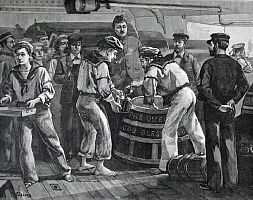 Today is “National Rum Day” in the United States. Why? Why not? In observation of the day, it seems worthwhile to consider the role of rum at sea.
Today is “National Rum Day” in the United States. Why? Why not? In observation of the day, it seems worthwhile to consider the role of rum at sea.
Before there was rum, there was water. The problem with water was that it could kill you or at least make you sick due to poor sanitation both ashore and at sea. During the Age of Exploration, Royal Navy ships would provide a gallon of beer for each sailor each day, both for healthy hydration and morale. The problem with beer was it would spoil in the heat and motion of an ocean voyage. Wine, brandy and other spirits were tried as substitutes, with varying degrees of success.
Rum entered the picture when sugar cane was brought to the Caribbean. Rum was introduced to the British Navy after 1655 when Vice-Admiral William Penn conquered Jamaica during Oliver Cromwell’s West Indies campaign as part of the Anglo-Spanish war. Rum was cheap, potent and didn’t spoil, making it popular with sailors and the Admiralty alike.
It wasn’t until 1731 when the rum ration became formalized in the “Regulations and Instructions Relating to His Majesty’s Service at Sea” The regulation dictated that one undiluted half-pint (2 gills) of rum was equal to a gallon of beer.
Rum turned out to be too much of a good thing. The undiluted rum led, not surprisingly, to drunkenness and disciplinary problems. In 1740, Vice Admiral Edward Vernon, nicknamed “Old Grog” after a grogram cloak that he preferred to wear, mandated that the rum ration would be cut with water. He also allowed for sailors to buy sugar and lime to improve the taste of their daily spirits. The lime juice also helped prevent scurvy. It wouldn’t be until 1795 that the British Royal Navy routinely gave lemon juice to its sailors to control the disease.
The US Navy was slower than the Royal Navy in the official adoption of a rum ration. In 1794, the US Navy established that sailors were to receive “one half-pint of distilled spirits” a day. It wouldn’t always be rum, however. With less access to Caribbean sugar, in 1806, the Navy encouraged the sailors to accept American corn whiskey as a substitute for the more expensive Caribbean rum.
The US Navy ration was reduced to one gill (four ounces) in 1842 and totally eliminated 1862 during the Civil War. The Confederate Navy continued to provide crews with rum rations, believing that the tradition would help recruit much-needed experienced sailors from other nations.
U.S. Navy sailors were allowed to keep their own stock of beers and undistilled spirits at the discretion of their commander until 1899, when even the sale of alcohol was banned to “enlisted men, either onboard ship, or within the limits of navy yards, naval stations, or marine barracks, except in the medical department.”
On July 1, 1914, the ships of the U.S. Navy officially became dry under General Order No. 99. “The use or introduction for drinking purposes of alcoholic liquors on board any naval vessel, or within any navy yard or station, is strictly prohibited, and commanding officers will be held directly responsible for the enforcement of this order…”
The Royal Navy continued its rum ration, although in progressively lower quantities, until July 31, 1970, known as Black Tot Day. The Canadian Navy went dry on March 31, 1972, and the New Zealand Navy held out until February 28, 1990.

The a R.A.N. were runners up stopping the tot n 1921.
Too funny. I am surprised with all the liquor flowing that anyone was able to hit anything during war.
Next year 31st July 2020 is the 50th anniversary of the stoppage of rum in the Royal Navy. For my ship’s reunion (HMS Loch Fada) next year we have managed to purchase a gallon of genuine ex Royal Navy rum pre 31/7/70 to help us commemorate Black Tot Day. An appropriate ceremony is planned.
Was the sun being over the yard arm actually a rule before the drinking could begin?